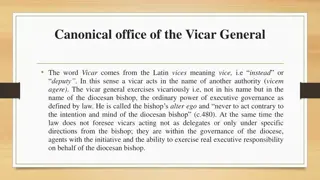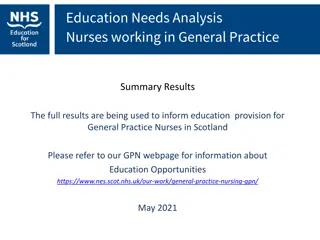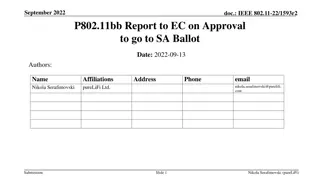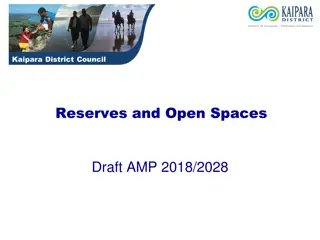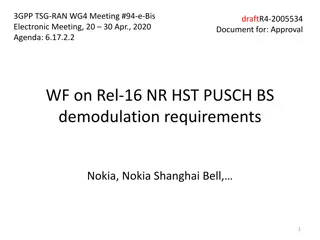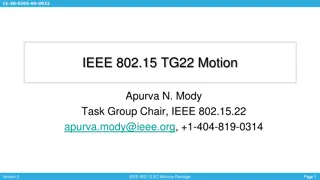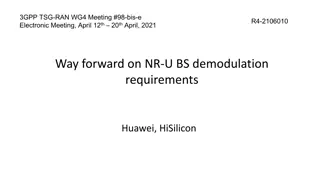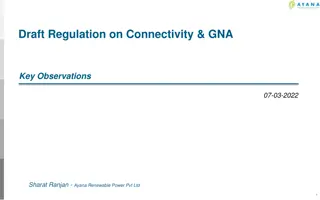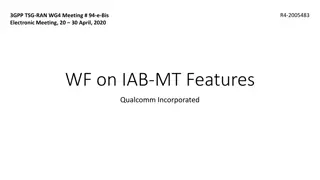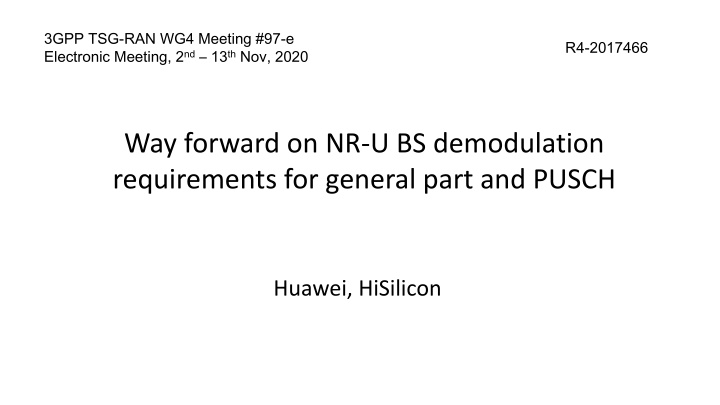
NR-U BS Demodulation Requirements and Testing Scenarios
"Learn about the demodulation requirements for NR-U base stations, including test scopes and scenarios for PUSCH bandwidth, waveform, and more. Explore the testing options and rules for performance requirements in a band-agnostic manner."
Download Presentation

Please find below an Image/Link to download the presentation.
The content on the website is provided AS IS for your information and personal use only. It may not be sold, licensed, or shared on other websites without obtaining consent from the author. If you encounter any issues during the download, it is possible that the publisher has removed the file from their server.
You are allowed to download the files provided on this website for personal or commercial use, subject to the condition that they are used lawfully. All files are the property of their respective owners.
The content on the website is provided AS IS for your information and personal use only. It may not be sold, licensed, or shared on other websites without obtaining consent from the author.
E N D
Presentation Transcript
3GPP TSG-RAN WG4 Meeting #97-e Electronic Meeting, 2nd 13thNov, 2020 R4-2017466 Way forward on NR-U BS demodulation requirements for general part and PUSCH Huawei, HiSilicon
Background R4-2012611, Way Forward on NR-U BS demodulation requirements, RAN4#96-e, Ericsson
General: Test scopes Define BS performance requirements as band agnostic way Test applicability Define the applicability rules based on BS s declaration on features rather than scenarios: The performance requirements for interlaced PUSCH should apply only if BS declares to support PUSCH with interlaced resource allocation The performance requirements for interlaced PUCCH should apply only if BS declares to support PUCCH with interlaced resource allocation The performance requirements for wideband PRACH should apply only if BS declares to support PRACH with long sequence L=1151 for 15kHz SCS and L=571 for 30kHz SCS How to handle Rel-15 test requirements for BS supporting NR-U Option 1: Reuse the existing Rel-15 test applicability rules for NR Rel-15 performance requirements testing Other options not precluded
General: Test Scenarios Define requirements that are agnostic to wideband operation 1 and 2 Not consider LBT model for NR-U BS performance requirements definition Always schedule PRBs between 2 contiguous LBT sub-bands during the test, i.e. not configure guard band
PUSCH Bandwidth Option 1: Define the requirements for single carrier with 20MHz only with the test applicability rule that a BS only has to perform tests for the largest supported bandwidth based on BS vendor s declaration. The applicability rule defined in NR Rel-15 for different channel bandwidths needs to applied: the tests shall be done only for the supported widest supported channel bandwidth. If performance requirement is not specified for this widest supported channel bandwidth, the tests shall be done by using performance requirement for the closest channel bandwidth lower than this widest supported bandwidth; the tested PRBs shall then be centered in this widest supported channel bandwidth. Option 2: Define the requirements for single carrier with 20MHz,40MHz,60MHz and 80MHz, with the test applicability rule that a BS only has to perform tests for the largest supported bandwidth based on BS vendor s declaration.
PUSCH Waveform: CP-OFDM Use first single interlace per slot. SCS: Both 15kHz and 30kHz Test applicability rule for different SCS: Test performance requirements for 15kHz and/or 30kHz SCS based on BS s declaration If BS declares to support both 15kHz and 30kHz Option 1: Only test performance requirements for 15kHz SCS or 30kHz Option 2: Test performance requirements for both 15kHz and 30kHz SCS TDD pattern: 7D2S1U S=6D:4G:4U for 30kHz SCS 3D1S1U S=10D:2G:2U for 15kHz SCS
PUSCH PUSCH mapping type Option 1: Only Type B Option 2: Both Type A and Type B Number of scheduled symbols for PUSCH transmission: 14 symbols per slot DM-RS configuration: DM-RS configure type 1 with single-symbol and dmrs-AdditionalPosition pos1 MCS MCS 20 for TDLA30-10? Antenna configuration: 1x2 Propagation condition: TDLA30-10?
PUSCH Maximum number of HARQ transmission: 4 RV sequence Option 1: {0,2,0,2} Option 2: {0,2,3,1} Test metric for PUSCH performance requirements: SNR@70% max throughput Performance requirements for CG-UCI multiplexed on PUSCH with interlace allocation Option 1: Not introduce Option 2: Introduce performance requirements for CG-UCI multiplexed on PUSCH with interlaced resource allocation and without HARQ-ACK, CSI part 1 and CSI part 2 Option 3: Consider introduce a Rel-15 requirement for HARQ-ACK multiplexing on PUSCH with more than 2 HARQ-ACK information bits and using it to cover CG-UCI multiplexing on CG-PUSCH in NR-U scenario with proper applicability rule



